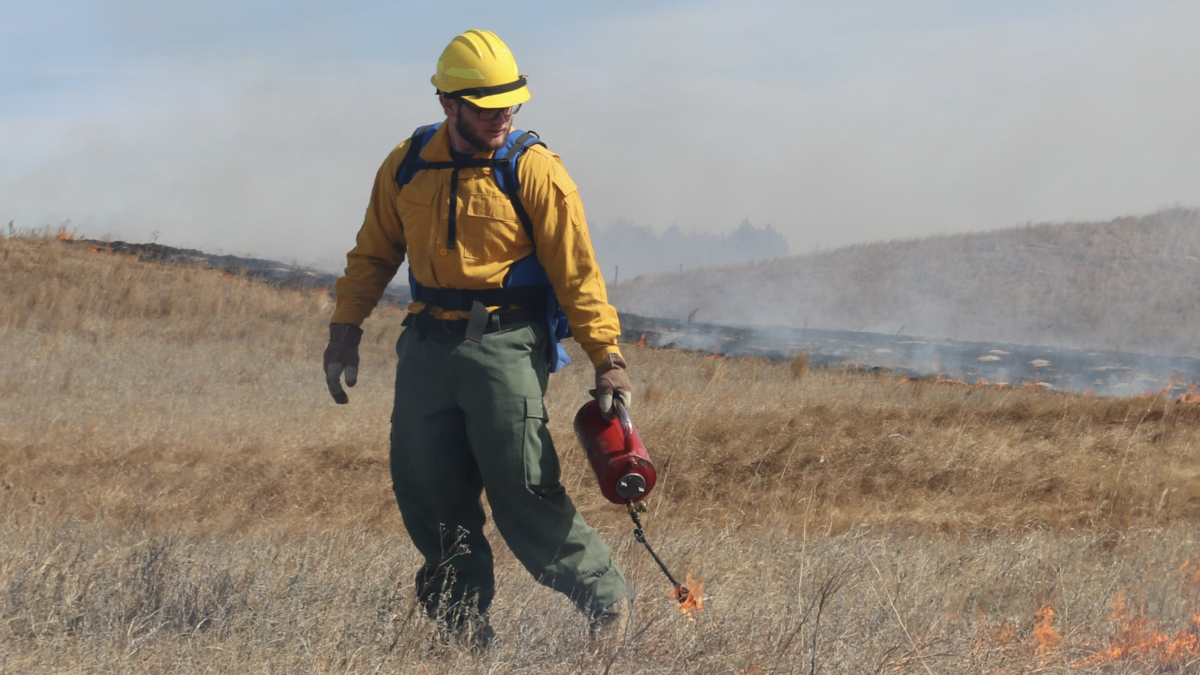
by Ronica Stromberg
A scientist testing how Sandhills grasslands fare with prescribed burns said initial findings indicate some grassland songbirds fare better with fire, especially the horned lark.
Nolan Sipe, a recent graduate of the University of Nebraska, researched the effect of fire on grasslands at the university’s Barta Brothers Ranch in 2022 and 2023 as part of his master’s project. In a collaborative adaptive management project led by Daniel Uden, rangeland scientist, Sipe and a team of researchers burned one of four 160-acre pastures each year. The team plans to burn the remaining two fields in 2024 and 2025 and then compare cattle-grazed land burned once every four years to land with traditional rotational grazing alone.
Sipe counted the numbers of birds and their species in the burned fields compared with the unburned fields. He observed horned larks by sight or sound 66 times, with 50 of the observations in the first burned field. He also observed more upland sandpipers, eastern kingbirds, mourning doves and common nighthawks in the burned fields. None of these birds are listed as endangered or threatened, but the Audubon Society website notes common nighthawks are “seriously declining,” and the bird is rated as a species of concern in Canada.
“All grassland songbird species are in a decline right now, more so than pretty much any other guild of bird species,” Sipe said. “So, anything we can do to encourage and protect these different types of habitat that attract these different types of birds is going to be very beneficial.”
Some grassland birds like the grasshopper sparrow had reduced numbers in the burned field but remained abundant in the unburned field.
Sipe said the change in bird numbers was likely caused by the use of fire along with grazing in the fields.
“I think that is because it's the habitat that the species prefer, that we cultivated through the burn,” he said. “For example, like the common nighthawk, it's a ground-nesting species, so it wants to be able to get access to the ground where it can create those nests. Other species like the grasshopper sparrow prefer a dense vegetation where they can build nests inside of the grasses, and then they're not so much a fly and go over species. They kind of hop around from grass to grass, and they use it as cover. So, without that cover, they're not as attracted to the area, but for those species that have evolved around using less dense vegetation, that's what they prefer.”
The fires burned away dead vegetation, and plants rebounded in different heights and densities. Sipe said such mixed vegetation is desirable because it provides habitat for more wildlife species.
“The whole idea behind the fire and grazing is creating a matrix of different habitats for different types of wildlife,” he said. “Through that, we have more wildlife, more diversity better able to respond to any changes or any disturbances.”
When the land experienced drought in spring 2023, researchers saw a drop in diversity in the control pasture but less so in the burned pasture, Sipe said.
The land retained pockets of wetlands, and he noted more wetland birds in those areas. He said wetland birds could be an area of further study, as well as burning in the fall instead of the spring. He studied soil nutrients pre- and post-burn and erosion in the burned pastures but noted no significant changes.
His academic advisor, Craig Allen, said the project recently received another five years of funding so researchers plan to burn again in spring 2024 and 2025 and then evaluate the effects. Besides continuing the research on birds and plants in grasslands undergoing fire treatments, Allen said researchers may study the way cattle preferentially graze lands in the four-year burn cycle, cattle weight gain on those lands and the effects of burns on invasive species like redcedar.
Uden said Sipe’s research is important for the Sandhills because it furthers understanding of how different kinds of management can benefit wildlife and keep grasslands resilient.
Nebraska ranchers have typically managed grasslands without burning them, but Native Americans historically burned them.
“Modern management for the Sandhills has been, we say, managed for the middle,” Sipe said. “They don't want to overgraze; they don't want to under graze. Overgrazing causes destabilization, erosion. They don't want that, but they don't want to under graze because then you're not utilizing it enough. So, they're managing for the middle, and by doing that, you create very similar vegetation across the whole area.”
Sipe has accepted a position with the L-A-D Foundation in Missouri, restoring and conserving woodlands with techniques such as prescribed burns.
“I'm confident he will continue having a positive impact on the environment and all that depend on it,” Uden said.